General Information:
As the name suggests, semi-aquatic mammals refers to any mammal which spends part of its time on land and part in the water. These mammals hunt for at least part of their food in water. Due to the large amount of time they spend in bodies of water, they have specific adaptations to help them thrive in aquatic environments. These include at least a partial webbing of their feet to help propel them through the water and fur that is designed to keep the mammals waterproof while they are swimming. The homes of semi-aquatic mammals can be found near a variety of water sources, though the home design differs based on the species.
There are five species of semi-aquatic mammals in Missouri – the nutria, common muskrat, American beaver, North American river otter, and American mink. The nutria is the only invasive species of the five, and thankfully it is the only species that is not found statewide.
These species are extremely connected within the food web. Otters and minks have been known to eat muskrats, and otters also eat baby beavers and minks. Since the nutria is not native to the area the otter has not adapted to eat it. Below is a simplified food web that shows the connections between these species.
All five of these mammals are trapped for their fur. They were all extensively trapped until the decline of the fur industry, and now trapping has decreased. Their fur is used for many clothes, including hats and coats. For the beaver and otter, trapping greatly reduced their numbers. The beaver has made a comeback on its own and otters were reintroduced in 1982 to help boost their numbers. In addition to being killed for their pelts, beavers, muskrats, nutria, and otters are also occasionally killed for meat. (Whitaker 572, 652, 678, 770, 785)
Taxonomy
The semi aquatic mammals in Missouri are split into two orders, Rodentia (rodents) and Carnivora (carnivores). The nutria, American beaver, and common muskrat belong to the Rodentia order while the North American river otter and American mink belong to the Carnivora order. Below is a more detailed classification of these mammals obtained from Wikipedia. I have omitted the species that do not live in Missouri.
Aquatic Mammals
- Order Carnivora
- Family Mustelidae
- Subfamily Lutrinae
- North American river otter (Lontra canadensis)
- Subfamily Mustelinae
- American mink (Neovison vison)
- Subfamily Lutrinae
- Family Mustelidae
- Order Rodentia
- Suborder Hystricomorpha
- Nutria (Myocastor coypus)
- Family Castoridae
- American beaver (Castor canadensis)
- Family Cricetidae
- Common muskrat (Ondatra zibethicus)
- Suborder Hystricomorpha
These five species can be placed into two different groups based on appearances; with the species from the Carnivora order in one group and those in the Rodentia order in the other.
Carnivora Species (American River Otter & American Mink)
Otters and minks are the two carnivorous semi-aquatic mammals in Missouri. They do not look extremely similar, but they share many characteristics. Both have elongated bodies, webbed feet, dark brown fur, and lighter colored throats. They can easily be distinguished from one another by their sizes and tails (see descriptions below).
Rodentia Species (Nutria, American Beaver, & Common Muskrat)
The nutria, beaver, and muskrat are all very similar in appearance. All three have orange incisors, partially webbed hindfeet, small ears and eyes, and similar body shapes. They all have scaly tails but the shape of their tails, which can be found in the information below, makes it easy to distinguish them from the others. In addition they vary in size, with the beaver being the biggest and the muskrat being the smallest.
Nutria (Myocaster coypus)
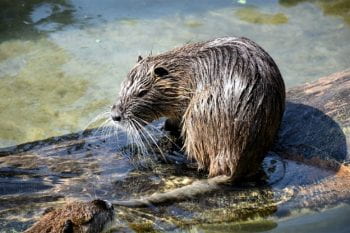
Nutria with rounded tail: RitaE from Pixabay, 2019. Free for commercial use.
Description
Nutria are large rodents. From their head to the end of their tail they range in size from 26 to 55 inches. They weigh between 15 and 25 pounds. Nutria look similar to muskrats and beavers, but they can be easily distinguished by their dark orange incisors and their rounded tails (Whitaker 677). While muskrats and beavers also have slightly orange teeth, nutria’s are much darker. Nutria have short front legs with unwebbed feet, while their back legs are long and have webbed feet (“Nutria (Coypu)”).
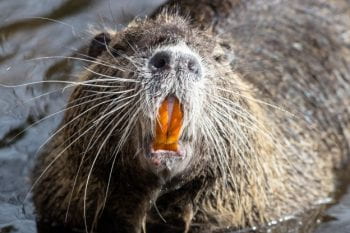
Nutria Teeth: Herbert Aust from Pixabay, 2018. Free for commercial use.
Background as an Invasive Species
Nutria were introduced into the United States through Louisiana. They were farmed in captivity their for their fur, but many escaped due to hurricane flooding in the 1940s (Whitaker 678). Nutria are now invasive in Missouri and many other states. They cause a lot of damage to coastal habitats. Nutria burrows lead to instability in river banks, and their feeding habits can lead to erosion (“Myocastor Coypus”). Shooting and trapping keeps the nutria population under control (“Myocastor Coypus”).
Habitat
So far nutria are only present in the southeastern corner of Missouri (“Nutria (Coypu)”). Nutria are found near water sources like swamps, marches, ponds, and streams (“Myocastor Coypus”). They make their nests out of plant materials in burrows that are either dug into a riverbed or in shallow water (Whitaker 678). Nutria also occasionally take over the burrows of beavers and muskrats (Whitaker 678).
Nutrition
Nutria feed on aquatic plants. They also consume some grains that they will dip into water before eating (Whitaker 678). Nutria consume so much food, 25% of their body weight every day, that keeping them in farms for their fur and meat is unprofitable to the farmers (“Nutria (Coypu)”). Nutria reingest their fecal pellets so they can completely digest food (Whitaker 678).
Breeding & Life Cycle
Nutria breed year round and can have up to three litters a year (“Nutria (Coypu)”). Their litters comprise 1-11 young, though a typical litter is 4-6 (Whitaker 677). The young are born fully haired and with their eyes open and they swim and eat within 24 hours (Whitaker 678). They leave home after eight weeks and can breed around three to four months old (“Nutria (Coypu)”). They can live to be 6 in captivity, but only live for about one year in the wild (“Nutria (Coypu)”).
Behavior
Nutria are very comfortable in the water; when they are startled on land they will quickly return to the water (Whitaker 678). Nutria can remain submerged for many minutes and they will frequently float just below the water’s surface with only their eyes and nose exposed (Whitaker 678). Nutria are most active at night. At dusk you can typically hear them making pig-like grunts (677).
Scientific Research
Scientific research on the nutria mostly focuses on its damage to wetlands and other habitats. Studies from Blair and Carter show how nutria’s excessive feeding can lead to erosion in swamps and wetlands. Another relevant study by Hilts models the future expansion of nutria into more of the United States as a result of global warming.
Common Muskrat (Ondatra zibethicus)
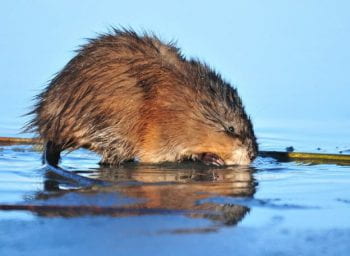
Common Muskrat: Tom Koerner from flickr, 2015. Licensed under CC BY 2.0
Description
Common muskrats range in size from 16 to 24 inches and they typically weigh around 4 pounds. Common muskrats have very small eyes and ears. While they look similar to nutria and beavers, they are much smaller in size and they have very distinctive tails. Common muskrat tails are laterally flattened and nearly hairless (Whitaker 649). This tail acts as a rudder to help the mammal maneuver through the water (“Common Muskrat”).

Muskrat laterally flattened tail: John Heinz from flickr, 2013. Licensed under CC BY 2.0
Habitat
Muskrats are found throughout the whole state of Missouri. Muskrats live in the same habitats as nutria, though they can also be found in rivers, lakes, and canals (Whitaker 650). Muskrats either live in above water lodges or in burrows in banks. Their lodges are dome shaped and made of plants (“Common Muskrat”). They look similar to beaver lodges, but they are much smaller (Whitaker 651). In addition to their homes, muskrats also build feeding platforms. These platforms are made of cut vegetation and they are slightly smaller than the animal’s lodges (Whitaker 650).
Nutrition
Muskrats eat mostly aquatic vegetation such as cattails and water lilies (“Common Muskrat”). Muskrats also eat some terrestrial plants (Whitaker 651). In some locations muskrats will also eat clams, fish, and frogs (Whitaker 651). Muskrats will drag their food back to their feeding platforms so they can eat without worrying about predators (“Common Muskrat”). Their mouth closes behind their incisors which allows them to chew while underwater (Whitaker 651).
Breeding & Life Cycle
Muskrats have 1-5 litters per year with 1-11 young (Whitaker 650). The young are born without fur and with their eyes closed (Whitaker 652). After two weeks they are fully furred and they are able to swim and dive (Whitaker 652). Muskrats are weaned when they are about a month old, after which they leave home and establish their own territories (“Common Muskrat”). They can mate when they are one year old (“Common Muskrat”). In the wild, the typical lifespan of muskrat is three to four years (“Common Muskrat”).
Behavior
Muskrats are extremely good swimmers and spend most of their time in the water. They are able to swim both forward and backwards with ease (“Common Muskrat”). Muskrats can remain submerged for up to 17 minutes (Whitaker 651). When they swim their head and back are both partially above the water (Whitaker 571). Muskrats are crepuscular, meaning they are most active at dawn, dusk, and night (“Common Muskrat”). However they may be seen at any time of the day (Whitaker 651).
Scientific Research
Not much scientific research has been done on the common muskrat. One study explains muskrats’ consumption of an endangered freshwater mussel (Edelman). Another discusses the genetic classification and conservation statues of the muskrat (Falcone).
American Beaver (Castor canadensis)

American Beaver: Steve Hersey from flickr, 2007. Licensed under CC BY-SA 2.0
Description
The American beaver is larger than the common muskrat and nutria at a range in size from 35 to 46 inches. They typically weigh between 40 and 60 pounds. The beaver’s tail makes it easy to identify. The tail is very large, and it is horizontally flattened into the shape of a paddle (Whitaker 568). The skulls and teeth of beavers are unusually large which is necessary to help them cut through wood (Anderson).
Habitat
Beavers are found statewide in Missouri. Beavers inhabit the same areas as the common muskrat. Beavers that live along a river will typically make burrows into the riverbank, while other beavers will build dams and a lodge (Whitaker 570). Beavers will build their lodges in one of three places – on an island, on a pond bank, or on the shore of a lake (Anderson). The lodges are made of sticks, grass, and moss that are stuck together with mud (Anderson). These lodges will typically have multiple underwater entrances.
In addition to lodges, beavers also build dams, canals, and channels. They typically do all of their construction during the night. Beavers build dams so they can control the flow of water. They use them both to slow the flow of water and to raise the water level before the dam (“Beaver Dams”). Dams differ depending on the speed of the river. In a slow moving river beavers will build dams that are straight across while dams build on fast moving rivers will be slightly curved (Anderson). Beavers build canals to connect their lodges to their favorite food sources (Anderson). They prefer moving in the water so this allows them to have easier access to their food. Beavers use channels as underground tunnels to connect their lodges to dry land (“Beaver Dams”).
Nutrition
Beavers eat bark and trees. Some of their favorite trees include poplar, aspen, willow, birch, and maple (Whitaker 570). They also eat some aquatic vegetation, mainly buds and roots (Anderson). Beavers will store food for the winter by felling (cutting down) trees and sticking them into the bottom of the bottom of a stream or pond (Whitaker 570).
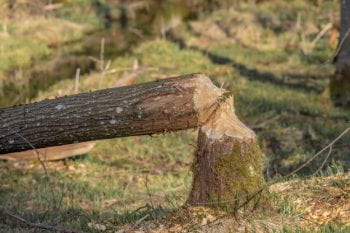
Tree felled by beaver: Michael Schwarzenberger from Pixabay, 2015. Free for commercial use.
Breeding & Life Cycle
Beavers are monogamous, meaning they only mate with one other beaver unless their mate dies (Anderson). They breed from late January to late February (Whitaker 569). They usually breed once a year (Anderson). Their litters can consist of 1-8 kits (baby beavers) though they typically have four or five (Whitaker 569). The young are born furred and with their eyes open (Whitaker 571). They can swim within a half hour of being born (Whitaker 571). Kits stay with their parents until they are about two years old, they are driven away from home right before the new litter is born (Anderson). Beavers are able to mate when they are three years old (Anderson). In the wild, they typically live to be 10 to 20 years old (Anderson).
Behavior
Beavers are mostly nocturnal. They are much more at ease in water than they are on the land. On land, beavers will constantly sniff the air and look for signs of danger (Whitaker 571). In the water beavers can swim as fast as six miles per hour, and they can stay underwater for 15 minutes (Whitaker 570). When they are swimming only their head is visible, unlike the muskrat (whitaker 571). Beavers live in families of up to eight individuals and they are very defensive of their territory (Anderson). They will slap their tails on the water to warn the members of their family of danger (Anderson).
Scientific Research
Scientific research on beavers typically concerns the impact of their dams on the local habitat. One study focuses on the effects their dams have on stream temperature (Weber). Another focuses on how beavers alter the structures of streams (Naiman).
North American River Otter (Lontra canadensis)
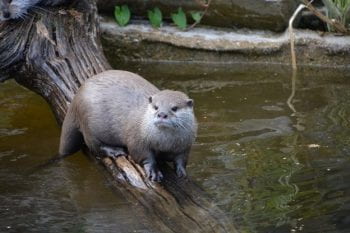
River Otter: A Owen from Pixabay, 2014. Free for commercial use.
Description
The North American river otter is a large mammal that ranges from 35 to 52 inches. These mammals weigh between 11 and 30 pounds. Otters have long narrow bodies and flattened heads that help them move underwater (“North American River Otter”). These mammals have long whitish whiskers (Whitaker 782). They have clawed feet that aid them in grasping their prey (“North American River Otter”).

Otter whiskers: Ben Lai from flickr, 2010. Licensed under CC BY-NC-ND 2.0
Habitat
The North American river otter can be found all over the state of Missouri in any water habitat (“North American River Otter”). Otters are also very comfortable on land and they will roam far from water (Whitaker 783). Otters live in dens in banks. They either dig these dens themselves, or inhabit the dens of other animals (Whitaker 785). Otters also rest in different locations outside of their dens, such as in hollow logs (Whitaker 785).
Nutrition
Otters mainly eat fish but they can be found consuming a variety of different things. On land otters eat small mammals, birds, and reptiles (“North American River Otter”). In the water some different things otters eat are aquatic plants and crayfish (“North American River Otter”). Otters catch fish in an interesting way. They dig themselves into the sand and wait for fish to swim near them (Whitaker 784).
Breeding & Life Cycle
Otters breed about once a year in early spring (Whitaker 783). They give birth to one to six young that are born fully furred with their eyes closed (Whitaker 783). The otters are helpless at birth and don’t learn to swim until they are about two months old (“North American River Otter”). The young are weaned at four months and they leave home in the winter before the next litter arrives (Whitaker 785). Otters generally live up to nine years in the wild (“North American River Otter”).
Behavior
Otters are extremely playful animals. They are active during the day and can be seen rolling around and sliding on land and diving and body surfing in the water (Whitaker 784). Otters will do this either on their own or in a group. Outside of just being for fun, these activities also serve the purpose of strengthening social bonds and allowing young otters to practice hunting (“North American River Otter”). In the water otters are able to swim very rapidly, both underwater and at the surface (Whitaker 784). They can stay underwater for several minutes and can dive up to 55 feet deep (Whitaler 784).
Scientific Research
Scientific research on the otter focuses on, among other things, the reintroduction of the species in the 1980s. One study focuses on the success of the reintroduction specifically in Missouri (Mowry). Another focuses on the abundance of otters after they were reintroduced (Ellington).
American Mink (Neovison vison)
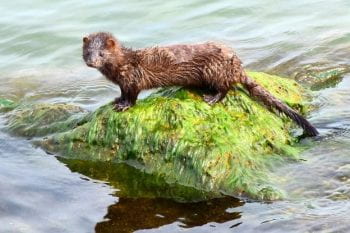
American Mink: Jan den Ouden from Pixabay, 2017. Free for commercial use.
Description
The American mink ranges from 19 to 28 inches and weighs between 1.5 and 3.5 pounds. These sleek bodied mammals look similar to weasels and ferrets, but can be distinguished by their chocolate brown to black fur (Whitaker 768). They also have white spots on their chins and throats. Minks have long tails that, unlike the other semi-aquatic mammals in Missouri, are furry. Their legs are short and they have clawed feet (Bradford).
Habitat
Minks are found in the entire state of Missouri. Minks live near bodies of water such as rivers, creeks, lakes, ponds, and marches (Whitaker 769). Unlike the other semi-aquatic mammals in Missouri, their homes are temporary. Minks live in dens of other animals, hollow logs, or dens that they dig into stream banks (Whitaker 769). To make their homes more comfortable, minks will add grass, leaves, and leftover fur from prey (Bradford).
Nutrition
Mink’s favorite food is the common muskrat (Whitaker 769). They also eat chipmunks, mice, rabbits, fish, snakes, frogs, and birds (Bradford). Minks will eat their food right where they catch it, or if they have extra they will take it back to their home to store it (Whitaker 769). Minks spend a lot of their time hunting for prey in ponds and streams (Whitaker 769).
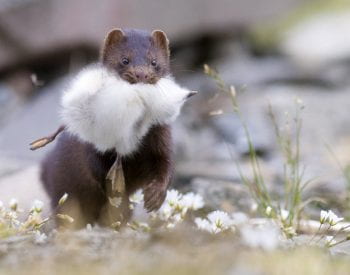
Mink with prey: Statskog SF from flickr, 2008. Licensed under CC BY-NC 2.0
Breeding & Life Cycle
Minks mate between January and April. They give birth to a litter of 1-10 blind and hairless young (Whitaker 768). The young are weaned around six weeks of age and leave home at six to ten months of age (Bradford).They are able to reproduce at ten to twelve months of age (Bradford). Male minks mate with multiple females but eventually live with one (Whitaker 769). In the wild, minks typically live for around three years.
Behavior
Minks are crepuscular, like muskrats, however they will adapt their hunting times to when prey is most available (Whitaker 769). They are solitary animals and are typically only together for breeding (Bradford). Minks spend much of their time hunting in the water (Whitaker 769). They can dive deeper than 16 feet and can swim up to 100 feet underwater (Bradford). Minks are very hostile and will hiss, snarl, or screech when angered or alarmed (Whitaker 769).
Scientific Research
There is not much scientific research on the American mink in the United States. The research that is done varies greatly. One study focuses on how the availability of its prey affects the habitat selection of minks in the summer (Wolff). There are many studies done on how the American mink is an invasive species in Europe.
References:
Anderson, Rebecca. “Castor canadensis.” Animal Diversity Web, University of Michigan, 2014.
“Beaver Dams and Canals.” Animal Trail.
Blair, Robert M., and Murphy J. Langlinais. “Nutria and Swamp Rabbits Damage Baldcypress Plantings.” Journal of Forestry, vol. 58, no. 5, 1960, pp. 388-389. Doi:10.1093/jof/58.5.388.
Bradford, Alina. “Facts About Minks.” LiveScience, 13 Sept. 2016.
Carter, Jacoby, et al. “Modeling the effects of nutria (Myocastor coypus) on wetland loss.” Wetlands, vol. 19, no. 1, 1999, pp. 209-219. Springer, doi:10.1007/BF03161750.
“Common Muskrat – Ondatra Zibethicus.” Nature Works, NHPBS.
Edelman, Andrew J., et al. “Muskrat Predation of Native Freshwater Mussels in Shoal Creek, Alabama.” Southeastern Naturalist, vol. 14, no. 3, 2015, pp. 473-483. BioOne Complete, doi:10.1656/058.014.0307.
Ellington, E. Hance, et al. “Assessment of river otter abundance following reintroduction.” Wildlife Research, vol. 45, no. 6, 17 Sept. 2018, pp. 490-499. Doi:10.1071/WR17164.
Falcone, Jon Hyde, et al. “Taxonomic and Conservation Status of the Pecos River Muskrat.” Texas Tech University, no. 359, 7 Jan. 2019, pp. 1-16.
Hilts, Dylan J., et al. “Climate change and nutria range expansion in the Eastern United States.” The Wildlife Society, doi:10.1002/jwmg.21629.
Mowry, R. A., et al. “Genetics and the successful reintroduction of the Missouri river otter.” Animal Conservation, vol. 18, no. 2, 2015, pp. 196-206. Doi:10.1111/acv.12159.
“Myocastor Coypus.” Global Invasive Species Database, 2008.
Naiman, Robert J., et al. “Alterations of North American Streams by Beaver.” BioScience, vol. 38, no. 11, 1988, pp. 753-762. Doi:10.2307/1310784.
“North American River Otter.” The National Wildlife Federation, https://www.nwf.org/Educational-Resources/Wildlife-Guide/Mammals/north-american-river-otter.
“Nutria (Coypu).” Missouri Department of Conservation.
Weber, Nicholas, et al. “Alteration of stream temperature by natural and artificial beaver dams.” PlosOne, 17 May 2017. Doi:10.1371/journal.pone.0176313.
Whitaker, John. National Audubon Society Field Guide to North American Mammals. Chanticleer Press Edition, Knopf Doubleday Publishing Group, 1996.
Wikipedia contributors. “Aquatic mammal.” Wikipedia, The Free Encyclopedia, 13 Nov. 2019.
Wolff, Patrick J., et al. “Habitat selection by American mink during Summer is related to hotspots of crayfish prey.” Wildlife Biology, vol. 21, no. 1, 2015, pp. 9-17. BioOne Complete, doi:10.2981/wlb.00031.
This page was produced by Kate Frauenheim in 2019